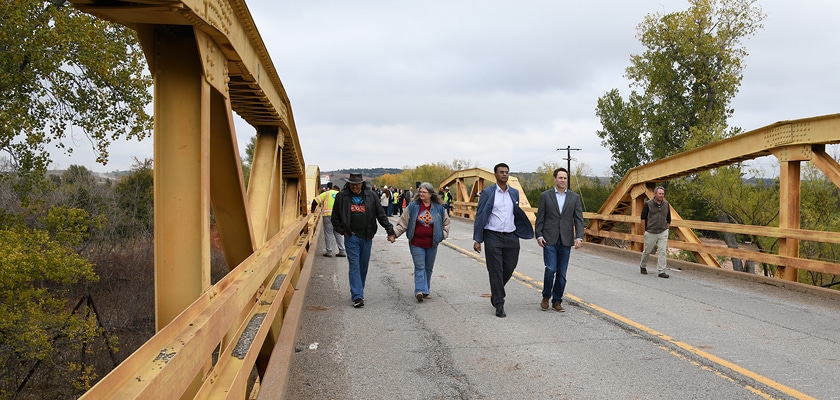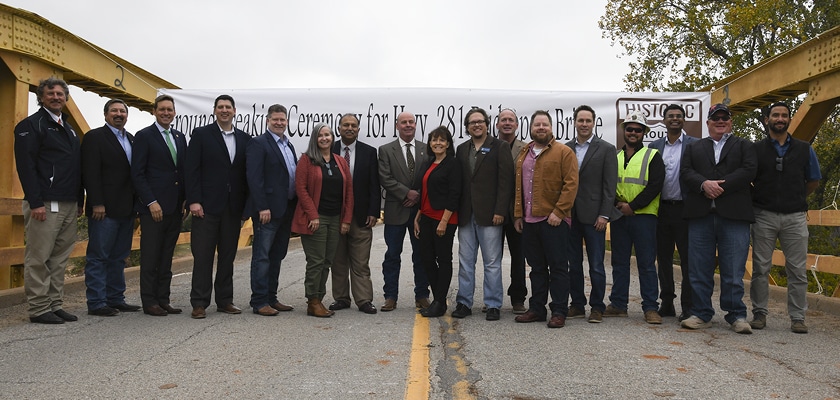History in the Making: STV Serves as Lead Designer for Innovative Route 66 Bridgeport Bridge
Feb 8, 2023

The iconic Route 66 Bridge in Oklahoma City, also known as the Bridgeport Bridge, is getting a long-awaited makeover that will not only maintain the look and feel of the historic bridge with its unique 38-100’ pony truss spans preserved as aesthetic panels but will also be the first highway bridge in Oklahoma to utilize full-depth precast concrete deck panels and Ultra-High Performance Concrete (UHPC) joints.
STV is serving as the lead designer for the $35 million bridge rehabilitation on behalf of the Oklahoma Department of Transportation (ODOT) and also provided reconnaissance data collection, stakeholder coordination, and an Alternatives Analysis Report study during the project’s planning stage.
“This bridge is one of the most important bridges on old Route 66 in the state and attracts tourists from all over the world,” David Neuhauser, STV vice president and project manager said. “We wanted to find a way to preserve the unique and iconic features of the bridge with its large number of truss spans, while making it usable to the public and removing the current load posting tonnage for large vehicles. By utilizing UHPC, we were able to implement emerging technology while also minimizing environmental disruptions.”
As part of the study, the team considered five alternatives, including three new potential highway alignments, reconstruction of the existing alignment, and closing the highway while maintaining the historic bridge as a monument. Ultimately, the decision was made by ODOT to rehab the bridge in a manner that met the desires of the various interested historic parties and while enhancing safety for motorists.
Normal concrete has a strength of about 3000-4000 psi, while UHPC has about 30,000 psi, making it an optimal bonding agent that also lends itself to accelerated bridge construction. This innovative solution was proposed by ODOT in order to pursue additional funding through grant programs set up by the Federal Highway Administration.
STV’s design called for the replacement of the existing truss spans with full-depth precast concrete panels on new, simple-span steel beams. Concrete pier caps were designed to retrofit the existing columns that were part of the original construction in 1933. The removed, existing truss panels were repainted and added to the outside of the pier caps as aesthetic, non-structural elements to preserve the experience of traveling across this long 40-span bridge structure, totaling almost a mile.
“Oklahoma encompasses the largest number of drivable miles on Route 66 out of any state,” Neuhauser said. “Tourism is the third largest economy of our state, so preserving this bridge will not only allow people to continue to enjoy a piece of history, it will also serve as a leading bridge in efficiency and pioneering design.”
The project area provides critical habitat for the Arkansas River Shiner, a federally threatened species necessitating seasonal construction considerations and conservation measures. By utilizing precast concrete deck panels, construction will not only move quicker, but also will be less disruptive to the environment. As part of the project, STV’s environmental group led all environmental studies and served as the prime for consulting services, including preparation of the Documented Categorical Exclusion. Other environmental responsibilities included assisting with Section 106 Consulting Party meetings, preparing materials for the virtual open house including notification materials, presentation materials, and the meeting webpage, coordinating the public comments matrix and providing meeting documentation.

Through the assistance of the U.S. Department of Transportation’s Better Utilizing Investments to Leverage Development (BUILD) Transportation Discretionary Grants program, ODOT was able to secure funding for the expensive UHPC. Working closely with ODOT and many stakeholders such as the Route 66 Association, the Federal Highway Administration, the Historic Bridge Foundation and other preservation groups, the STV team analyzed the existing substructure and performed material testing of existing piers. The team concluded it was feasible to utilize the substructure and set the new structure on top of it, allowing for a portion of the history of the bridge to be maintained. This approach was largely supported and applauded by historic preservation groups.
STV also designed the parking lot and kiosk area to be constructed at the end of the bridge. This provides a location for visitors to stop and view the structure, learn about the history and significance of the bridge, and enhances the preservation efforts.
“It was truly an honor and privilege to work on a historic project of this magnitude,” Neuhauser added. “To be able to help preserve a piece of history that so many people across the state and tourists from around the world traverse every day was really special.”
Ribbon-cutting ceremony photos courtesy of the Oklahoma Department of Transportation; Video courtesy of Gared Findley at West OK Oakland